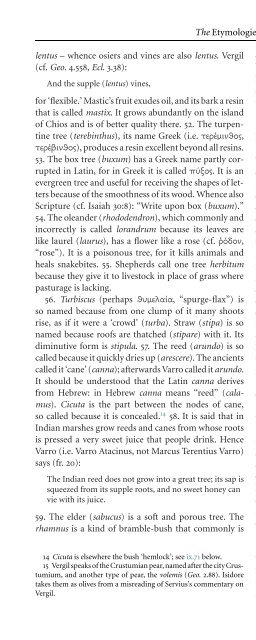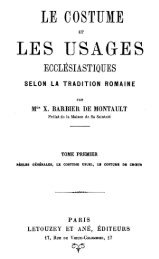The Etymologies of Isidore of Seville - Pot-pourri
The Etymologies of Isidore of Seville - Pot-pourri
The Etymologies of Isidore of Seville - Pot-pourri
You also want an ePaper? Increase the reach of your titles
YUMPU automatically turns print PDFs into web optimized ePapers that Google loves.
lentus –whence osiers and vines are also lentus. Vergil<br />
(cf. Geo. 4.558, Ecl. 3.38):<br />
And the supple (lentus) vines,<br />
for ‘flexible.’ Mastic’s fruit exudes oil, and its bark a resin<br />
that is called mastix. Itgrows abundantly on the island<br />
<strong>of</strong> Chios and is <strong>of</strong> better quality there. 52. <strong>The</strong>turpentine<br />
tree (terebinthus), its name Greek (i.e. ,<br />
), produces a resin excellent beyond all resins.<br />
53. <strong>The</strong>boxtree(buxum) hasaGreekname partly corrupted<br />
in Latin, for in Greek it is called . Itisan<br />
evergreen tree and useful for receiving the shapes <strong>of</strong> letters<br />
because <strong>of</strong> the smoothness <strong>of</strong> its wood. Whence also<br />
Scripture (cf. Isaiah 30:8): “Write upon box (buxum).”<br />
54.<strong>The</strong> oleander (rhododendron), which commonly and<br />
incorrectly is called lorandrum because its leaves are<br />
like laurel (laurus), has a flower like a rose (cf. ,<br />
“rose”). It is a poisonous tree, for it kills animals and<br />
heals snakebites. 55. Shepherds call one tree herbitum<br />
because they give it to livestock in place <strong>of</strong> grass where<br />
pasturage is lacking.<br />
56. Turbiscus (perhaps , “spurge-flax”) is<br />
so named because from one clump <strong>of</strong> it many shoots<br />
rise, as if it were a ‘crowd’ (turba). Straw (stipa) isso<br />
named because ro<strong>of</strong>s are thatched (stipare) withit.Its<br />
diminutive form is stipula. 57. <strong>The</strong>reed (arundo) isso<br />
called because it quickly dries up (arescere). <strong>The</strong> ancients<br />
called it ‘cane’ (canna); afterwards Varro called it arundo.<br />
It should be understood that the Latin canna derives<br />
from Hebrew: in Hebrew canna means “reed” (calamus).<br />
Cicuta is the part between the nodes <strong>of</strong> cane,<br />
so called because it is concealed. 14 58. Itissaid that in<br />
Indian marshes grow reeds and canes from whose roots<br />
is pressed a very sweet juice that people drink. Hence<br />
Varro (i.e. Varro Atacinus, not Marcus Terentius Varro)<br />
says (fr. 20):<br />
<strong>The</strong> Indian reed does not grow into a great tree; its sap is<br />
squeezed from its supple roots, and no sweet honey can<br />
vie with its juice.<br />
59. <strong>The</strong>elder (sabucus) isas<strong>of</strong>tandporoustree.<strong>The</strong><br />
rhamnus is a kind <strong>of</strong> bramble-bush that commonly is<br />
14 Cicuta is elsewhere the bush ‘hemlock’; see ix.71 below.<br />
15 Vergil speaks <strong>of</strong> the Crustumian pear, named after the city Crustumium,<br />
and another type <strong>of</strong> pear, the volemis (Geo. 2.88). <strong>Isidore</strong><br />
takes them as olives from a misreading <strong>of</strong> Servius’s commentary on<br />
Vergil.<br />
<strong>The</strong> <strong>Etymologies</strong> XVII.vii.52–vii.68 347<br />
called bear-briar (sentix ursina), a very rough and thorny<br />
bush. 60.<strong>The</strong> briar-bush (sentix)isnamedfrom‘wasteland’<br />
(situs), which is uncultivated land in which briars<br />
and thorns grow. Our ancestors would call every prickly<br />
tree a thornbush (vepris), because it ‘clings forcefully’<br />
(vi prendere).<br />
61. <strong>The</strong>wildolive (oleaster) issocalled because it<br />
has leaves like the olive’s (oliva; cf. the pejorative suffix<br />
-aster) but broader. It is an uncultivated and wild tree,<br />
bitter and unfruitful. A branch <strong>of</strong> olive grafted on a wild<br />
olive changes the potency <strong>of</strong> its root and converts the tree<br />
into its proper character as an olive. <strong>The</strong> sap <strong>of</strong> the wild<br />
olive is <strong>of</strong> two kinds. One is like gum without any biting<br />
quality, the other is ammoniac pitch collected from the<br />
drippings, and is biting. 62.<strong>The</strong>olive (oliva)inGreekis<br />
called (“olive oil”; cf. , “olive-tree, olive”),<br />
whence it has been taken into Latin as oliva.Butthetree<br />
itself is olea, thefruit oliva, andthe oil oleum. <strong>The</strong>tree<br />
is a symbol <strong>of</strong> peace, and its fruits are called by diverse<br />
names. 63.<strong>The</strong>orchas olive has a Greek etymology, and is<br />
so called from its likeness to a testicle, which the Greeks<br />
call . 64.<strong>The</strong>radiola olive is sonamed because it is<br />
elongated like a ray (radius). <strong>The</strong> Paphian olive is named<br />
for the island <strong>of</strong> Paphos from which it was first imported.<br />
65.<strong>The</strong>lycinia olive, because its oil gives the best light, for<br />
means “light” (cf. ,“lamp”). From this the<br />
word ‘firewood’ (lignum) also receives its name, because<br />
it is good for burning and light.<br />
66.<strong>The</strong>pausia olive, which country people incorrectly<br />
call pusia (i.e. posia), is good for its sweet and green oil.<br />
It is called pausia because it is ‘pounded down’ (pavire),<br />
that is, crushed – from this word also comes ‘pavement’<br />
(pavimentum). 67. <strong>The</strong> Syrian olive is so called because<br />
it was brought over from Syria, or because it is darkskinned.<br />
<strong>The</strong> crustumia olive is also called the volemis, 15<br />
so called because it fills the palm (vola), that is, the middle<br />
<strong>of</strong> the hand, with its large size; from this root we also<br />
have the word ‘seize’ (involare). However, some understand<br />
the word volemus to mean “good” and “large”<br />
in the Gallic language. Pickled olives (colymbas) areso<br />
called . . .<br />
68. ‘Oliveoil’(oleum) isnamed from the olive tree<br />
(olea), for as I have already said, olea is the tree, from<br />
which is derived the word oleum. Butwhat is pressed<br />
from white olives is called ‘Spanish oil,’ and <br />
in Greek. What is pressed from tawny, immature olives<br />
is called ‘green oil,’ but what comes from overly mature

















